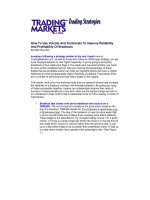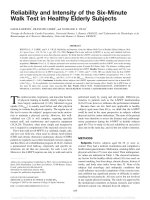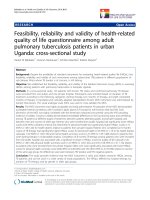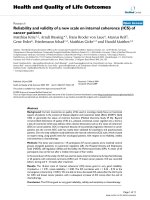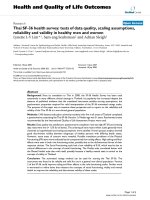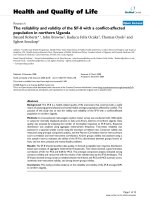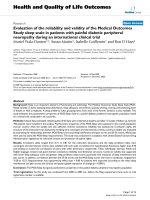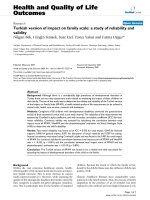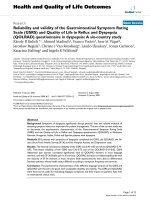Reliability and validity of the Japanese version of the Mental Health Selfmanagement Questionnaire among people with mental illness living in the community
Bạn đang xem bản rút gọn của tài liệu. Xem và tải ngay bản đầy đủ của tài liệu tại đây (747.18 KB, 11 trang )
Morita et al. BMC Psychology
(2019) 7:30
/>
RESEARCH ARTICLE
Open Access
Reliability and validity of the Japanese
version of the Mental Health Selfmanagement Questionnaire among people
with mental illness living in the community
Yasuko Morita1* , Yuki Miyamoto1, Ayumi Takano2, Norito Kawakami3 and Simon Coulombe4
Abstract
Background: Self-management is an important factor in maintaining and promoting mental health and recovery
from mental health challenges. Thus, it is important to assess and support mental health self-management. In this
study, we aimed to develop the Japanese version of the Mental Health Self-management Questionnaire (MHSQ-J),
a scale to assess mental health self-management strategy, and clarify its psychometric properties among people
with mental illness living in Japan.
Methods: An anonymous self-administered survey including MHSQ-J was conducted for psychiatric outpatient
users (N = 295), and 104 of the participants completed MHSQ-J again about two weeks later. Internal consistency
was assessed with Cronbach’s α, and test-retest reliability was confirmed by the intraclass correlation coefficient
(ICC). Construct validity was assessed based on structural validity with confirmatory factor analysis (CFA) and
exploratory factor analysis (EFA), and hypotheses testing. The Self-management Skill Scale, the University of Tokyo
Health Sociology version of the Sense of Coherence Scale ver1.2, the Japanese version of Self-identified Stage of
Recovery Part-B, the Japanese version of the Flourishing Scale, and the Japanese version of the WHO Disability
Assessment Scale 2.0 were used for hypotheses testing.
Results: Data from 243 respondents were analyzed. The result of CFA, the goodness-of-fit indices showed marginal
fit (AGFI = .830, CFI = .852, RMSEA = .072). EFA identified three factors (Clinical, Empowerment, and Vitality), and the
results suggested that the factor structure of the Japanese version of MHSQ was similar to the original 3-factor
structure. Significant correlations were found with the hypotheses testing variables related to self-management and
recovery, especially on the total score, the Empowerment subscale, and the Vitality subscale. Cronbach’s α (Clinical:
.65, Empowerment: .81, Vitality: .75, Total: .83) and ICC (Clinical: .75, 95% confidence interval (CI) [.62, .84],
Empowerment: .81, 95% CI [.70, .88], Vitality: .62, 95% CI [.44, .75], Total: .84, 95% CI [.75, .90]) indicated good
reliability.
Conclusion: The results show that MHSQ-J has acceptable reliability and validity to measure the use of self-management
strategies for mental health among community living people with mental illness in Japan.
Keywords: Mental health, Mental illness, Self-management, Community, Outpatient
* Correspondence:
1
Department of Psychiatric Nursing, Graduate School of Medicine, The
University of Tokyo, 7-3-1, Hongo, Bunkyo-ku, Tokyo 113-0033, Japan
Full list of author information is available at the end of the article
© The Author(s). 2019 Open Access This article is distributed under the terms of the Creative Commons Attribution 4.0
International License ( which permits unrestricted use, distribution, and
reproduction in any medium, provided you give appropriate credit to the original author(s) and the source, provide a link to
the Creative Commons license, and indicate if changes were made. The Creative Commons Public Domain Dedication waiver
( applies to the data made available in this article, unless otherwise stated.
Morita et al. BMC Psychology
(2019) 7:30
Background
Self-management is a subjective day-to-day approach including medical management, role management and emotional aspects of their condition, which is engaged to
improve health conditions and maintain wellness [1]. This
self-management starts with a person addressing their
own difficulties and concerns in their daily life [1]. Selfmanagement improves several aspects of life with chronic
illness, such as symptoms, self-efficacy and Quality of Life
(QOL) [2, 3].
Mental health guidelines and guidance have pointed out
the importance of self-management to complement
pharmacotherapy and psychotherapy in the treatment of
mental illness [4–6]. The reported benefits of self-management for mental health include higher self-efficacy, a
lower relapse rate, higher sense of coherence, better
self-rated health, and fewer comorbidities [7, 8]. Additionally, self-management is essential to promoting “recovery”
[8]. Recovery means not only improvement in clinical aspects such as a reduction of symptoms, but also personal
aspects such as transformation of attitudes or ways of
thinking, enabling patients to live their life more satisfactorily and with hope [9, 10].
To support the recovery of the people with mental health
challenges, it is important to assess and support their
self-management behavior as the outcome of their
self-management. Behavior is all actions, not only those externally observable, but also inner actions like thoughts or
recognitions. In the mental health area, most of the scales
for measuring self-management are limited by the diagnosis
or situation of use such as a psychiatric vocational rehabilitation service. Nowadays, much of the mental health welfare support services within a community are provided to
users without the distinction of a diagnosis. Furthermore, a
program style that doesn’t require information regarding
the diagnosis is not uncommon when the aim is to facilitate
recovery. Thus, a trans-diagnostic scale that measures
self-management behavior is needed to improve mental
health support services in the community. The Patient Activation Measure 13 for Mental Health [11] measures mental health self-management attitudes, and a Japanese
version is available [12], but not for self-management
behavior. It is desirable to be able to measure not only attitudes, but also behaviors, because motivation and cognitive
function are often impaired by mental illness.
The Mental Health Self-management Questionnaire
(MHSQ) [13] was developed to measure the use of
self-management strategies to recover from mood and
anxiety disorders as users empower themselves and take
responsibility in their recovery [13]. The items were extracted from qualitative research that clarified strategies to
recover from mood and anxiety disorders [14]. MHSQ
contains 18 items and consists of three factors (Clinical,
Empowerment, and Vitality). Responses are given on a
Page 2 of 11
5-point Likert scale ranging from 0 (Never used) to 4 (Very
often used). A higher score indicates more frequent use of
self-management strategies over the past two months. The
three factors were described as follows: “Clinical” refers to
getting help and using resources, “Empowerment” relates
to building upon strengths and a positive self-concept to
gain control, and “Vitality” refers to an active and healthy
lifestyle [13]. MHSQ is reported to have satisfactory
reliability, examined by Cronbach’s α (Clinical = .69,
Empowerment = .81, Vitality = .75) and the test-retest reliability of each factor using intraclass correlation coefficient
(ICC) (Clinical: ICC = .78, 95%CI [.68, .85]; Empowerment:
ICC = .76, 95%CI [.65, .84]; Vitality: ICC = .85, 95%CI [.78,
.90]) [13]. The validity of the original MHSQ was examined by content validity, concurrent validity, convergent
validity, and discriminant validity from the recovery concept [13]. MHSQ is an adequate scale to measure the use
of self-management strategy which tends to be highly individualized. Although the original MHSQ focuses on persons with mood and anxiety disorders, it is reasonable to
adopt it for other mental diagnosis because of the following points. In the development process of MHSQ,
disease-specific items were excluded [13]. It is suggested
that the core aspects of self-management for a chronic illness are common, and are as follows: problem solving, decision making, resource utilization, forming a patient/
healthcare provider partnership, and taking action [1, 15].
It can be considered that the remaining items were a
common strategy to deal with mental health challenges.
That is why we recognized that MHSQ can be adopted to
other mental diagnoses. Accordingly, it is assumed that if a
Japanese version of MHSQ were to be developed, it would
contribute to the assessment of mental health
self-management behavior in people with mental health
challenges.
The aim of this study is to develop a Japanese version of
MHSQ (MHSQ-J) and to clarify its psychometric properties among people with mental illness living in Japan. To
verify reliability and validity, internal consistency, test-retest reliability, structural validity, hypotheses testing and
cross-cultural validity, these components are examined according to the COnsensus-based Standards for the selection of health Measurement Instruments (COSMIN)
checklist [16, 17]. We aimed to verify the following hypotheses. MHSQ-J has a positive correlation with scores
of the scales associated with self-management behavior
and personal recovery and has a negative correlation with
scores of the scales associated with clinical recovery.
Method
Ethical considerations
The study protocol was approved by the Ethical Committee of the Graduate School of Medicine/Faculty of
Medicine, the University of Tokyo (11513). Aims,
Morita et al. BMC Psychology
(2019) 7:30
procedures, the voluntary nature of participation, anonymity, and privacy protection were explained using a
Participant Information Sheet. In addition, participants
were informed that refusal or suspension of participation
would not cause any disadvantage. Participants gave
their consent by responding to the questionnaire.
Study design and participants
This is a validation study for MHSQ-J, and its psychometric properties were validated according to the COSMIN checklist. An anonymous survey administered to
people living in the community with mental illness was
conducted from July to October in 2017. We recruited
295 outpatients from outpatient mental health clinic A
(site A), B (site B), and the psychiatric mental health
outpatient service C (site C) in a psychiatric hospital. All
the facilities were in the Kanto region. Clinic A is in a
commuter town, and clinic B is in an office building of a
large city. Site C has over 600 beds, and is separate from
an alcohol use disorder specialty outpatient facility.
Inclusion criteria were: outpatients ≥20 years old that
understood Japanese. Outpatients who were regarded as
having mental health instability by the professional staff
working at the site were excluded. Mental health instability
was considered in cases of the following: 1) Patients for
whom answering this questionnaire would be an excessive
burden and participation would be a hindrance to their
treatment because of their symptoms or participation in a
clinical trial; 2) the relationship with their doctor was not
well established because it was a first doctor visit or had
just started recently, or, being prone to problems from the
past. At site A, as a first step, the doctor asked an eligible
patient to participate in this study and to meet the
researcher after the consultation. Subsequently, the researcher provided an explanation about this research to
patients that agreed to meet us, and obtained consent for
participation. At sites B and C, the researcher confirmed
patient eligibility or the conditions which the specialists at
the facility considered patients to be ineligible. The researcher asked patients about eligibility conditions (e.g., “Is
this your first visit to this clinic?”) when necessary. If the
patient was eligible, the researcher asked if they would
agree to participate in this study. The researcher or facility
staff explained the study to patients using a Participant Information Sheet.
Test-retest reliability was tested among participants
who agreed to receive the retest by mail (n = 104).
Measurements
Development procedure of the Japanese version of MHSQ
(MHSQ-J)
The following procedure was used to translate MHSQ,
based on the principles described by Wild [18].
Page 3 of 11
(1) Preparation and forward translation: first,
permission to translate MHSQ into Japanese was
obtained from its original author. MHSQ was
originally developed in French, and the original
author provided an English version for Japanese
development. Two native Japanese speakers, who
were mental health researchers having experience
in psychiatric nursing, carried out independent
translations of MHSQ from English to Japanese.
(2) Reconciliation: five mental health researchers in
face-to-face meetings including the author reached
a consensus on a draft Japanese translation of
MHSQ that best reflected the literal and conceptual
content of the English version of MHSQ.
(3) Back translation: the draft version was backtranslated into English by a professional native
English translator, who did not know about the
English version of MHSQ.
(4) Back translation review and harmonization: the
researchers who conducted the forward translations
reviewed the back-translation to ensure the literal
and conceptual equivalence of the translation. The
original author also confirmed the back translation.
(5) Cognitive debriefing and finalization: ten Japanese
people using community mental health services
tested the pre-final Japanese version of MHSQ to
confirm whether the items on the questionnaire
were subjectively relevant and appropriate to the
situation of their self-management behavior. They
were also asked what they thought about the items
after answering the questionnaire. The authors
confirmed the cognitive equivalence of the translated
MHSQ-J (Additional file 1).
Scales for verifying hypotheses testing
Five scales were used for hypotheses testing to verify the
construct validity of MHSQ-J. The scales assessing correlation with self-management behavior were the Self-management Skill Scale (SMS) [19] and the University of Tokyo
Health Sociology version of the SOC scale (SOC-3-UTHS)
[20–22]. The scales assessing correlation with recovery
were the Japanese version of the Self-identified Stage of Recovery Part-B (SISR-B) [23, 24], the Japanese version of the
Flourishing Scale (FS-J) [25, 26], and the Japanese version
of the 12-item self-administered version of the WHO Disability Assessment Scale 2.0 (WHODAS 2.0) [27–29].
(1) Scales related to Self-management behavior
Self-management skill scale
Engaging in desirable health behavior is a part of self-management behavior. Cognitive skills such as effective ways of
thinking to achieve the behavior are related to health behavior [30]. The Self-management Skill Scale (SMS) is a
Morita et al. BMC Psychology
(2019) 7:30
scale for measuring general cognitive skills that are effective
in realizing the behavior that one wishes and that can be
utilized in various situations [19, 31]. The relation of the
high score of SMS to various health behaviors was previously confirmed [32, 33]. SMS is a 10-item scale including
six reverse-scored items. The items are rated on 4-point
Likert scales ranging from 1 (Not applicable) to 4 (Applicable). A higher score indicates an abundance of self-management skill. Cronbach’s α coefficient was reported as .75
among university students in Japan [19].
The University of Tokyo health sociology version of the SOC
scale ver.1.2
The University of Tokyo Health Sociology version of the
SOC scale (SOC-3-UTHS) ver.1.2 is a scale assessing Sense
of Coherence (SOC). SOC is a concept that reflects the
ability to cope with stress in Salutogenesis theory [34, 35].
As problems in mental health are linked with stress,
self-management and the ability to cope with stress was
assumed to have a relationship. Positive and significant associations were reported between SOC scores and
self-management behavior among people with chronic
illness [36]. SOC-3-UTHS ver.1.2 consists of three items.
Responses are on a 7-point scale, from 1 (Not applicable)
to 7 (Applicable). The items are scored so that a higher
score indicates a higher ability to cope with stress. Cronbach’s α coefficient was reported as .84 among a Japanese
population [21].
(2) Scales related to recovery
Japanese version of self-identified stage of recovery part-B
Personal recovery, an important aspect of recovery from
mental illness [9], was assessed using the Japanese version
of Self-identified Stage of Recovery Part-B (SISR-B), a
4-item scale to assess the key component of the process of
recovery from mental illness [23]. Items are rated on a
6-point scale, ranging from 1 (Disagree strongly) to 6
(Agree strongly). Cronbach’s α coefficient was reported as
.82 among people with mental illness living in the community. A higher score indicates a higher level of recovery [24].
Japanese version of flourishing scale
The Japanese version of the Flourishing Scale (FS-J) was
used to measure psychological well-being as a state of
increased personal recovery [37]. FS-J is an 8-item scale.
Items are rated on a 7-point scale, ranging from 1
(Strongly disagree) to 7 (Strongly agree). Higher scores
indicate respondents that view themselves in positive
terms in diverse areas of human functioning. Cronbach’s
α coefficient was reported as .95 among undergraduate
students in Japan [26].
Page 4 of 11
Japanese version of the 12-item self-administered version of
WHO disability assessment scale 2.0
Because self-management affects clinical recovery, such
as through a reduction of symptoms or disability [9], the
Japanese version of the 12-item self-administered version
of the WHO Disability Assessment Scale 2.0 (WHODAS
2.0) was used to assess the level of clinical recovery. This
scale assesses the degree of disability due to various
health conditions, with responses on a 5-point scale ranging from 1 (None) to 5 (Extreme/cannot do), where a
higher score indicates a higher level of disability [29].
Cronbach’s α coefficient was reported as .92 among preoperative patients in Japan [38].
Demographic variables
Information regarding socio-demographic and clinical
characteristics was collected, including age, sex, income,
marital status, work status, educational background, cohabitants, diagnoses of psychiatric disorders, period from
first visit to psychiatrist, an experience of hospitalization
due to mental health problems, the use of mental health
support services, frequency of visits with psychiatrists,
and severities of depression and anxiety. The severities
of depression and anxiety were assessed using the Japanese version of the Patient Health Questionnaire-9
(PHQ-9) [39–41] and the Japanese version of General
Anxiety Disorder-7 (GAD-7) [41, 42], respectively.
PHQ-9 has nine items, and GAD-7 has seven items.
Both are based on 4-point scales. Cronbach’s α coefficient of PHQ-9 was reported as .91 among university
students [43], and that of GAD-7 was reported as. 87
among university students in Japan [44].
Statistical analysis
Statistical analysis was conducted for respondents who
completely answered all items of MHSQ-J.
Validity of MHSQ-J
Since there was no gold standard for assessing self-management strategy, validity was determined by assessing
construct validity. Construct validity was confirmed by
structural validity, cross-cultural validity, and hypotheses
testing.
According to the COSMIN checklist [16], confirmatory
factor analysis (CFA) was performed to confirm the fit of
the factor structure of the original MHSQ to the data for
structural validity. Cross-cultural validity was also examined by CFA. The following indices were used: Adjusted
Goodness of Fit Index (AGFI), Comparative Fit Index
(CFI), and Root Mean-Square Error of Approximation
(RMSEA). AGFI and CFI values equal to or above .95 were
considered a good fit [45, 46]. An RMSEA value less than
or equal to .06 was considered a good fit, .08 or less indicates reasonable fit, .08 to .10 indicates a mediocre fit, and
Morita et al. BMC Psychology
(2019) 7:30
values above .10 indicate a poor fit [46, 47]. Factorial correlations were also examined.
Exploratory factor analysis (EFA) was performed to
verify structural validity along with CFA. The
Kaiser-Meyer-Olkin index (KMO) of sampling adequacy
and Bartlett’s chi-square test of sphericity with p < .05
were examined to confirm the suitability of the data for
factor analysis. KMO was compared to adequacy of standards [48]. The generalized least-squares method with
Promax rotation was used for the factor extraction because it was assumed that the factors have correlations
with each other. The number of factors was determined
based on the Scree test.
Pearson’s correlation coefficients were examined between the scales for hypotheses testing and the total
score and each factor of MHSQ-J. The hypotheses for
MHSQ-J score were as follows: positive associations with
the scores of SMS, SOC-UTHS ver.1.2, SISR-B, and
FS-J, moderate negative association was assumed with
WHODAS 2.0. Pearson’s correlation coefficients of
.40–.70 and > .70 were considered moderate and strong,
while .20–.40 and < .20 were considered weak and poor
correlations, respectively.
Reliability of MHSQ-J
To evaluate reliability, internal consistency and
test-retest reliability were calculated. Cronbach’s α coefficient for total score and each subscale of MHSQ-J were
examined to assess internal consistency. Sufficient internal consistency was assumed for a Cronbach’s α
greater than .70 [49, 50]. Test-retest reliability was tested
among participants who agreed to receive the retest by
mail (n = 104). Participants were asked to take a
re-administration of MHSQ-J two weeks later after the
initial questionnaire and we used data from all responses
(n = 82) that were provided within a period of 8–20 days
from the initial survey. Test-retest reliability was evaluated by exclusion of responses that reported significant
changes in their condition between the initial survey and
the test-retest survey. Participants were also asked about
changes in their subjective condition (“Were there any
changes in your condition since the time you previously
answered this survey?”) using an original item on a
7-point Likert scale ranging from “7: Extremely improved” to “1: Extremely worsened” to confirm significant differences in their condition compared with the
initial survey. We judged that there was a significant
change in condition at the retest if the participants answered the question as 1, 2, 6, or 7. For test-retest reliability, ICC was examined for the total score and each
subscale of MHSQ-J using the data with complete
answers for MHSQ-J. ICC > .70 considered as excellent
agreement [51].
Page 5 of 11
Statistical analyses, except for CFA, were conducted
using SPSS 22.0 for Windows. CFA was conducted using
AMOS version 22. Values of p less than .05 were considered statistically significant (two-tailed test).
Results
Respondent characteristics and scale descriptions
A total of 266 participants returned the questionnaire (response rate = 90%) and 82 returned the retest (response
rate = 79%). For all analyses, 23 respondents were excluded because of incomplete answers in MHSQ-J, and a
total of 243 were used. Socio-demographic and clinical
characteristics of the respondents are shown in Table 1.
The mean age was 46.3 (SD = 12.3), and the range was
between 21 and 82. Almost half of the respondents were
male and not married. There were 44% who lived alone,
and 41% had hospitalization experience because of mental
problems. The mean frequency of hospital/clinic visits per
month was 2.3 (SD = 2.0). Average period from the first
visit to the psychiatric/psychosomatic doctor was 11.9
years (SD = 9.8). The mean score of total MHSQ was 38.5
(SD =11.5, range 5–71). A ceiling effect was seen with
item 5, and a floor effect was seen with items 4 and 18.
Validity of MHSQ-J
Structural and cross-cultural validity
CFA was performed with all items, based on the structure of the original MHSQ (Fig. 1: Confirmatory factor
analysis of MHSQ-J). The goodness-of-fit indices were
not optimal, but marginal (AGFI = .830, CFI = .852,
RMSEA = .072). The factorial correlation between Empowerment and Vitality was .66. The correlations between Clinical and the other two factors were .30 with
Empowerment, and .15 with Vitality.
The adequacy of data for EFA was confirmed by Bartlett’s
test of sphericity (p < .001) and KMO (.842). The
goodness-of-fit test for the factor extraction method was
adequate (χ2 = 120.381, df = 102, p = .103). The three-factor-structure indicated by the Scree plot was optimal. The
three factors of MHSQ-J explained 47.83% of the variance.
Whole factor loadings are shown in Table 2. Three items
(item 4, 13, and 14) loaded onto two factors with low factor
loadings (< .40) and had comparable values over .20. The
inspection of kurtosis and skewness indices for the total
score and each factor were tested, and the results were:
Total: kurtosis −.382, skewness −.018; Clinical: kurtosis
−.224, skewness −.033; Empowerment: kurtosis −.347,
skewness −.189; Vitality: kurtosis −.596, skewness −.042.
Hypotheses testing
Significant correlations except for the Clinical subscale
were confirmed as being in the same direction as the hypotheses (Table 3). The total score, the Empowerment
subscale and the Vitality subscale of MHSQ-J showed a
Morita et al. BMC Psychology
(2019) 7:30
Page 6 of 11
Table 1 Socio-demographic and clinical characteristics of the
respondents
Table 1 Socio-demographic and clinical characteristics of the
respondents (Continued)
Total population N = 243
Total population N = 243
Characteristics
n (Mean)
% [SD]
Characteristics
Sex
n (Mean)
% [SD]
4
1.6
Visiting nurse
34
14.0
Psychiatric day care / day night care
24
9.9
Missing
Male
128
52.7
Missing
4
1.6
Use of supporta
Age
Missing
(46.3)
[12.3]
Employment support service
28
11.5
9
3.7
Return to work program
9
3.7
Psychotherapy
12
4.9
137
56.4
Other
52
21.4
Marital status
Not married
Married
65
26.7
Nothing particular
128
52.7
Divorced/Widowed
36
14.8
Missing
25
10.3
Other
1
0.4
Missing
4
1.6
0–9 (Minimal to Mild)
122
50.2
10–14 (Moderate)
62
25.5
< 2,500,000
52
21.4
15–27 (Moderately severe to Severe)
55
22.6
< 4,500,000
54
22.2
Missing
4
1.6
< 7,000,000
31
12.8
PHQ-9
Income (Yen)
GAD-7
≥ 7,000,000
26
10.7
0–9 (Minimal to Mild)
171
70.4
Livelihood protection
38
15.6
10–14 (Moderate)
43
17.7
Unknown, Answer refused
34
14
15–21 (Severe)
26
10.7
Missing
8
3.3
Missing
3
1.2
a
Educational background
Junior high school
17
7.0
High school
59
24.3
Junior college /vocational school
49
20.2
Bachelor’s degree or higher
110
45.3
Missing
8
3.3
Regular employment
53
21.8
Part time job
24
9.9
Work status
Working
: Multiple answers
PHQ-9 Patient Health Questionnaire-9, GAD-7 General Anxiety Disorder-7
significant positive correlation with SISR-B, FS-J,
SOC-3-UTHS ver.1.2 and SMS, and a significant negative correlation with WHODAS 2.0. The Clinical subscale showed a significant correlation only with
WHODAS 2.0, and the correlation was very weak.
Reliability of MHSQ-J
Others
42
17.3
Not working
110
45.3
Missing
14
5.8
Diagnosisa
Depression
100
41.2
Bipolar Disorder
32
13.2
Anxiety disorder
43
17.7
Substance use disorder
9
3.7
Developmental disorder
34
14.2
Schizophrenia
72
29.6
Unknown
5
2.1
Others
27
11.1
(1) Internal consistency
The Cronbach’s α coefficients of the total score and
each subscale of MHSQ-J, and the coefficient when an
item was deleted, are shown in Table 2. Cronbach’s α of
the total score, the Clinical subscale, the Empowerment
subscale, and the Vitality subscale were .83, .65, .81, and
.75, respectively.
(2) Test-retest reliability
In total, there were 82 responses for the retest, and 20
responses were excluded because of the following reasons: incomplete answers for MHSQ-J (n = 7), significant
change in condition at the retest (n = 9), not within the
period of 8–20 days from the initial survey (n = 3), or the
Morita et al. BMC Psychology
(2019) 7:30
Page 7 of 11
Fig. 1 Confirmatory factor analysis of MHSQ-J
reply date of the retest was unidentified (n = 1). Finally, 62
responses were used to examine test-retest validity, and
the mean period of the two tests was 13.9 days (SD = 1.83,
range = 11–20).
The ICC scores of MHSQ-J were as follows: Total
score: .84, 95% confidence interval (CI) [.75, .90], Clinical: .75, 95% CI [. 62, .84], Empowerment: .81, 95% CI
[.70, .88], and Vitality: .62, 95% CI [.44, .75]. Overall, the
scores showed moderately good test-retest reliability.
The ICC score of each item of the Vitality subscale were
also examined. The scores were as follows, item 15: .32,
95% CI [.08, .53], item 16: .66, 95%CI [.50, .78], item 17:
.58, 95% CI [.39, .73], and item 18: .65, 95% CI [.47, .77].
Discussion
This study aimed to develop and verify the reliability
and validity of MHSQ-J. The results indicated adequate
internal consistency, test-retest reliability, structural validity, and cross-cultural validity.
Regarding structural validity, the result for the CFA
using the original factorial structure showed almost acceptable factor loadings and a marginal goodness-of-fit
index score. The result for the EFA was that the highest
factor loadings of items 13 and 14 were for Vitality, although these items of the original MHSQ loaded in Empowerment. But it is reasonable to suppose that they
belong to Empowerment as on the original scale, based
on the size of the factor loadings. Therefore, it seems
reasonable to consider the structure of MHSQ-J as similar to the original MHSQ among the participants in this
study. The correlations between factors were moderate
and positive between the Empowerment factor and the
Vitality factor, but weak between the Clinical factor and
the other two factors. This trend was similar to the original results (r = .48 between Empowerment and Vitality,
r = .23 between Clinical and Empowerment, and r = .28
between Clinical and Vitality), and the original author indicated that the Empowerment and the Vitality subscales
of MHSQ might contain related sub-aspects which differ
from the Clinical subscale [13].
Concerning hypotheses testing, the scale related to
self-management and recovery showed significant correlations with the total score, the Empowerment subscale,
and the Vitality subscale of MHSQ-J in the hypothesized
direction. On the other hand, the Clinical subscale
showed no correlation with any scales used for hypotheses testing in this study. This seems consistent with the
results for the Clinical subscales of the original MHSQ,
which showed a significant correlation of smaller than
.30 on the scales of symptoms and on the social participation scale [13]. The original author explained that
“strategies from the Clinical subscale, such as consulting
a mental health professional, might be implemented
earlier in the recovery process when symptoms are most
Morita et al. BMC Psychology
(2019) 7:30
Page 8 of 11
Table 2 Means, standard deviations (SDs), factor loadings, and Cronbach’s α coefficients for the total score and MHSQ-J factors (N = 243)
Items of MHSQ-Ja (α = .83) and original factors with Cronbach's α
coefficient
Mean
Clinical factor (α = .65)
SD
Cronbach's α coefficient
if the item was deleted
Factor loadingb
Factor 1
Factor 2
Factor 3
For the total
For the
original factor
10.4
3.9
1 I look for available resources to help me with my difficulties
(websites, organizations, healthcare professionals, books, etc.).
1.7
1.3
.096
.032
.363
.83
.63
2 I consult with a professional (a physician, psychologist, social
worker, etc.) for my mental health problem.
2.2
1.2
-.039
.033
.745
.83
.54
3 I get actively involved in my follow-up with the healthcare
professionals I consult (physician, psychologist, social worker, etc.).
2.1
1.4
.028
.009
.722
.83
.51
4 I participate in a support or help group in order to help me
manage the difficulties I’m experiencing.
0.8
1.2
-.075
.222
.347
.83
.64
5 I take medication for my mental health problem, following
the indications of a healthcare professional.
3.6
0.9
.110
-.047
.379
.83
.65
Empowerment factor (α = .81)
20.6
7.3
6 I try to solve my difficulties one step at a time.
2.5
1.1
.546
.032
.204
.82
.79
7 I try to recognize the warning signs of a relapse of my mental
health disorder.
2.4
1.3
.524
.011
.300
.82
.79
8 I learn to differentiate between my mental health problem and
myself as a person.
1.7
1.4
.613
-.164
.162
.82
.80
9 I focus my attention on the present moment.
2.2
1.2
.564
-.107
.091
.82
.80
10 I learn to live with my strengths and weaknesses.
2.6
1.2
.582
-.041
.018
.82
.80
11 I congratulate myself on my successes, whether small or large.
2.1
1.2
.718
.124
-.188
.82
.78
12 I try to love myself as I am.
1.8
1.3
.690
.218
-.299
.82
.79
13 I take my capabilities into account when arranging my schedule.
2.4
1.2
.231
.246
-.019
.83
.82
2.3
1.3
.262
.386
.165
.82
.80
8.3
3.9
14 I find comfort and an attentive ear in the people around me.
Vitality factor (α = .75)
15 I engage in activities I like in order to maintain an active life.
2.6
1.2
.080
.578
.083
.82
.71
16 I engage in sports, physical activity.
1.9
1.3
-.229
.870
-.031
.83
.66
17 I have a healthy diet.
2.4
1.3
.090
.599
-.027
.82
.70
18 I do exercises to relax (yoga, tai-chi, breathing techniques, etc.).
1.4
1.4
-.034
.670
.110
.82
.71
a: The latest English version (2017) of MHSQ was obtained from the author of MHSQ by private communication
b: Factor loadings were based on exploratory factor analysis with generalized least-squares method and promax rotation
Table 3 Pearson’s Correlation Coefficients between the total and each MHSQ-J factor with the score of hypotheses testing
measures
SMS
SOC-3-UTHS ver. 1.2
n
Pearson’s correlation coefficients
MHSQ-J total
Clinical factor
Empowerment factor
Vitality factor
Cronbach’s
α coefficients
236
.321b
−.066
.365b
.325b
.77
237
b
−.050
b
.371b
.81
b
b
b
.85
.341
.361
SISR-B
236
.437
−.010
.519
.410
FS-J
235
.538b
.019
.578b
.467b
217
−.296
WHODAS 2.0
a
b
a
.157
−.347
b
.85
−.385
b
.86
< .05, b < .001
SISR-B Self-identified stage of recovery -B, FS-J Japanese version of the Flourishing Scale, SOC-3-UTHS The University of Tokyo Health Sociology version of the SOC
scale, SMS Self-management Skill Scale, WHODAS WHO Disability Assessment Schedule
Morita et al. BMC Psychology
(2019) 7:30
severe” [13]. Furthermore, while WHODAS 2.0 was used
to assess mental health clinical recovery, it might not be
sensitive enough to measure clinical recovery in mental
illness. WHODAS 2.0 measures the disability caused
from all health problems including physical problems,
which might be one of the reasons weakening the correlation between the Clinical subscale and clinical recovery.
In this study, MHSQ-J showed good reliability in terms
of reasonable Cronbach’s α coefficients and ICCs. The
Cronbach’s α coefficients indicated excellent internal
consistency in the total score, the Empowerment subscale,
and the Validity subscale. The internal consistency of the
Clinical subscale was acceptable, but relatively low. This result was consistent with the results for the original MHSQ
(Clinical = .69, Empowerment = .81, Vitality = .75) [13].
The ICCs of the total score, the Clinical subscale, and
the Empowerment subscale were satisfactory, and the
ICC of the Vitality subscale was acceptable, but relatively
low, especially for item 15.
In addition, a ceiling effect on item 5 (the use of medicine), and a floor effect on items 4 and 18 (participation
in a group which supports or helps oneself, and exercises
to relax, respectively), were seen in this study. Regarding
the ceiling effect, most of the participants took medication frequently, because they were all outpatient users.
Regarding the floor effect, the groups described in item
4 and the activity for relaxation described in item 18 are
not familiar to all people in Japan with mental illness.
This study has limited generalizability. Participants were
limited to psychiatric outpatients. And the participants
were also limited in terms of who could answer the questionnaire and their symptoms, such that cognitive function and concentration seemed to be high. We did not
collect information about the diagnosis from the clinic.
This was also a limitation of this study as we could not
eliminate a participant that uses psychiatric or psychosomatic outpatient services without psychiatric illness.
This is the first scale to measure the usage of mental
health self-management strategies in Japan. In this study,
the small difference between the original and the Japanese version of MHSQ in model fit and factor structure
probably is based on cross-cultural differences and differences in the participants. Although we developed and
analyzed this scale faithfully to the original scale, the results indicate the need to modify some items from a
cross-cultural and trans-diagnostic point of view. The
present study could not clarify the nature of each factor
in MHSQ-J. To provide greater usefulness for MHSQ-J,
and an understanding of self-management for mental
health, further study is needed to more readily adapt services for people with mental illness living in the community in Japan, and to clarify which factors are more
important at various points of treatment, or depending
on symptoms.
Page 9 of 11
Conclusion
MHSQ-J is valid and it reliably measures the use of
self-management strategies for mental health among
people with mental illness living in a Japanese community.
Additional file
Additional file 1: Japanese version of Mental Health Self-management
Questionnaire (MHSQ-J). (DOCX 33 kb)
Abbreviations
AGFI: Adjusted Goodness of Fit Index; CFA: confirmatory factor analysis;
CFI: Comparative fit index; COSMIN: COnsensus-based Standards for the selection
of health Measurement Instruments; EFA: Exploratory factor analysis; FSJ: Japanese version of the Flourishing Scale; GAD-7: Japanese version of General
Anxiety Disorder-7; ICC: Intraclass correlation coefficient; KMO: Kaiser-Meyer-Olkin
index; MHSQ: Mental health self-management questionnaire; MHSQ-J: Japanese
version of mental health self-management questionnaire; PHQ-9: Japanese version
of patient health questionnaire-9; QOL: Quality of Life; RMSEA: Root Mean-Square
Error of Approximation; SISR-B: Self-identified Stage of Recovery Part-B; SMS: Selfmanagement Skill Scale; SOC: Sense of Coherence; SOC-3-UTHS: The University of
Tokyo Health Sociology version of the SOC scale; WHODAS 2.0: WHO Disability
Assessment Scale 2.0
Acknowledgements
I would like to express my sincere gratitude to all the participants who
cooperated in this survey, and the facility staff that graciously accepted this
investigation. Finally, I thank all the members of the Department of Mental Health/
Psychiatric Nursing for their continuous encouragement and helpful support.
Funding
This study was partially supported by The Japan Agency for Medical Research
and Development (AMED, grant number: 17dk0307066h0001) and KAKENHI
Grant Number JP19K10923.
Availability of data and materials
The data supporting the findings of this study are available from Y. Morita,
but restrictions apply to the availability of these data, which were used
under license for the current study, and so are not publicly available. Data is
available from the authors upon reasonable request and with permission
from Y. Morita.
Authors’ contributions
YM1, AT, YM2 and NK contributed to the conception and design of the study.
YM1, YM2 and SC contributed to the development procedure of the Japanese
version of MHSQ, including forward translation and back translation review.
YM1 and AT contributed to the acquisition of data. YM1 analyzed the data and
wrote the first draft of the manuscript. AT, YM2 and NK supervised the analysis
and helped to draft and revise the manuscript. All authors read and approved
the final manuscript.
Ethics approval and consent to participate
The study protocol was approved by the Ethical Committee of the Graduate
School of Medicine/Faculty of Medicine, the University of Tokyo (11513).
Participants gave their consent by responding to the questionnaire.
Consent for publication
Not applicable.
Competing interests
The authors declare that they have no competing interests.
Publisher’s Note
Springer Nature remains neutral with regard to jurisdictional claims in published
maps and institutional affiliations.
Morita et al. BMC Psychology
(2019) 7:30
Author details
1
Department of Psychiatric Nursing, Graduate School of Medicine, The
University of Tokyo, 7-3-1, Hongo, Bunkyo-ku, Tokyo 113-0033, Japan.
2
Department of Mental Health and Psychiatric Nursing, Tokyo Medical and
Dental University, 1-5-45, Yushima, Bunkyo-ku, Tokyo 113-8510, Japan.
3
Department of Mental Health, Graduate School of Medicine, The University
of Tokyo, 7-3-1, Hongo, Bunkyo-ku, Tokyo 113-0033, Japan. 4Department of
Psychology, Faculty of Science, Wilfrid Laurier University, 75 University
Avenue West, Waterloo, Ontario N2L 3C5, Canada.
Received: 17 September 2018 Accepted: 9 April 2019
References
1. Lorig KR, Holman H. Self-management education: history, definition,
outcomes, and mechanisms. Ann Behav Med. 2003;26(1):1–7.
2. Foster G, Taylor SJC, Eldridge SE, Ramsay J, Griffiths CJ. Self-management
education programmes by lay leaders for people with chronic conditions.
Cochrane Database Syst Rev. 2007;(4):CD005108.
3. Newman S, Steed L, Mulligan K. Self-management interventions for chronic
illness. Lancet. 2004;364(9444):1523–37.
4. National Institute for Health and Care Excellence. Bipolar disorder:
assessment and management 2014(NICE Clinical guideline 185). 2014.
Accessed 6 June 2017.
5. Lam RW, McIntosh D, Wang J, Enns MW, Kolivakis T, Michalak EE, Sareen J,
Song W-Y, Kennedy SH, MacQueen GM. Canadian network for mood and
anxiety treatments (CANMAT) 2016 clinical guidelines for the management
of adults with major depressive disorder: section 1. Disease burden and
principles of care. Can J Psychiatry. 2016;61(9):510–23.
6. Australian Health Ministers’ Advisory Council. A national framework for recoveryoriented mental health services 2013. (2013) />main/publishing.nsf/content/67d17065514cf8e8ca257c1d00017a90/$file/
recovgde.pdf. Accessed 7 June 2017.
7. van Schie D, Castelein S, van der Bijl J, Meijburg R, van Stringer B, van Meijel
B. Systematic review of self-management in patients with schizophrenia:
psychometric assessment of tools, levels of self-management and
associated factors. J Adv Nurs. 2016;72(11):2598–611.
8. Houle J, Gascon-Depatie M, Bélanger-Dumontier G, Cardinal C. Depression
self-management support: a systematic review. Patient Educ Couns. 2013;
91(3):271–9.
9. Anthony WA. Recovery from mental illness: the guiding vision of the mental
health service system in the 1990s. Psychosoc Rehabil J. 1993;16(4):11–23.
10. Provencher HL, Keyes CLM. Complete mental health recovery: bridging
mental illness with positive mental health. J Public Mental Health. 2011;
10(1):57–69.
11. Hibbard JH, Stockard J, Mahoney ER, Tusler M. Development of the patient
activation measure (PAM): conceptualizing and measuring activation in
patients and consumers. Health Serv Res. 2004;39(4p1):1005–26.
12. Fujita E, Kuno E, Kato D, Kokochi M, Uehara K. Development and validation
of the Japanese version of the patient activation measure 13 for mental
health. Clin Psychiatry. 2010;52(8):765–72 (In Japanese).
13. Coulombe S, Radziszewski S, Trépanier SG, Provencher H, Roberge P, Hudon
C, Meunier S, Provencher MD, Houle J. Mental health self-management
questionnaire: development and psychometric properties. J Affect Disord.
2015;181:41–9.
14. Villaggi B, Provencher H, Coulombe S, Meunier S, Radziszewski S, Hudon C,
Roberge P, Provencher MD, Houle J. Self-Management Strategies in
Recovery From Mood and Anxiety Disorders. Global Qualitative Nursing
Research 2015;2:2333393615606092.
15. Lorig K. Living a healthy life with chronic conditions: self-management of
heart disease, arthritis, stroke, diabetes, asthma, bronchitis, emphysema and
others. 3rd ed. Palo Alto, Calif.: Bull Pub. Co.; 2006.
16. Mokkink LB, Terwee CB, Patrick DL, Alonso J, Stratford PW, Knol DL, Bouter
LM, de Vet HC. COSMIN checklist manual. Amsterdam: University Medical
Center; 2012.
17. Terwee CB, Mokkink LB, Knol DL, Ostelo RW, Bouter LM, de Vet HC. Rating
the methodological quality in systematic reviews of studies on
measurement properties: a scoring system for the COSMIN checklist. Qual
Life Res. 2012;21(4):651–7.
18. Wild D, Grove A, Martin M, Eremenco S, McElroy S, Verjee-Lorenz A, Erikson P.
Principles of good practice for the translation and cultural adaptation process
Page 10 of 11
19.
20.
21.
22.
23.
24.
25.
26.
27.
28.
29.
30.
31.
32.
33.
34.
35.
36.
37.
38.
39.
40.
41.
42.
for patient-reported outcomes (PRO) measures: report of the ISPOR task force
for translation and cultural adaptation. Value Health. 2005;8(2):94–104.
Takahashi H, Nakamura M, Kinoshita T, Masui S. Development and validation of a
self-management skill scale. Jpn J Public Health. 2000;47(11):907–14 (In Japanese).
Antonovsky A. Unraveling the mystery of health: how people manage stress
and stay well. San Francisco, CA: Jossey-Bass Publishers; 1987. [Translated in
to Japanese by Yamazaki Y and Yoshii K: Tokyo, Yushindo 2001]
Togari T, Yamazaki Y, Nakayama K, Shimizu J. Development of a short version of
the sense of coherence scale for population survey. J Epidemiol Community
Health. 2007;61(10):921–2.
Togari T. 3 koumoku-ban-SOC-shakud (SOC3-UTHS ver1.2) ni-tsuite. http://d.
hatena.ne.jp/ttogari-tky/files/3%E9%A0%85%E7%9B%AE%E7%89%88S
OC%E5%B0%BA%E5%BA%A6.pdf. Accessed 6 July 2017. (In Japanese).
Andresen R, Oades L, Caputi P. The experience of recovery from
schizophrenia: towards an empirically validated stage model. Aust N Z J
Psychiatry. 2003;37(5):586–94.
Chiba R, Kawakami N, Miyamoto Y, Andresen R. Reliability and validity of the
Japanese version of the self-identified stage of recovery for people with long
term mental illness. Int J Ment Health Nurs. 2010;19(3):195–202.
Diener E, Wirtz D, Tov W, Kim-Prieto C, Choi D, Oishi S, Biswas-Diener R.
New well-being measures: short scales to assess flourishing and positive
and negative feelings. Soc Indic Res. 2010;97(2):143–56.
Sumi K. Reliability and validity of Japanese versions of the flourishing scale
and the scale of positive and negative experience. Soc Indic Res. 2014;
118(2):601–15.
Tazaki M, Yamaguchi T, Yatsunami M, Nakane Y. Measuring functional health
among the elderly: development of the Japanese version of the World
Health Organization disability assessment schedule II. Int J Rehabil Res. 2014;
37(1):48–53.
Ustun TB, K N, Chatterji, S. Rehm, J. Measuring health and disability: manual for
WHO disability assessment schedule (WHODAS 2.0). 2010. [Translated into
Japanese by Tazaki M, Yamaguchi T and Nakane T: Tokyo, Institute of Resilient
Medicine 2015].
World Health Organisation. Disability assessment schedule. WHO Disability
Assessment Schedule 2.0. />en/. Accessed 6 July 2017.
Jingu H. Sukiru-no-ninchi-shinrigaku-koudou-no-puroguramu-wo-kangaeru.
Japan: Kawashima-shoten; 1993.
Sakuma H, Takahashi H, Takehana Y, Hisano Y. The relationship between
high school student’s stress responses and self-management skills. Jpn J
School Health. 2009;51(3):193–201 (In Japanese).
Takehana Y, Takahashi H. Relationship between self-management behavior
and cognitive skills in type 2 diabetes mellitus patients. Jpn J Public Health.
2002;49(11):1159–68 (In Japanese).
Fujiyoshi M, Tsutsui A, Matsuoka N, Hanioka T. Analyses in the factors of
toothbrushing behavior and knowledge, and attitude toward toothbrushing, and
gingivitis and plaque accumulation status. J Dental Health. 2005;55(1):3–14 (In
Japanese).
Antonovsky A. The structure and properties of the sense of coherence scale.
Soc Sci Med. 1993;36(6):725–33.
Antonovsky A. The salutogenic model as a theory to guide health promotion.
Health Promot Int. 1996;11(1):11–8.
Aujoulat I, Mustin L, Martin F, Pélicand J, Robinson J. The application of
Salutogenesis to health development in youth with chronic conditions. In: The
handbook of Salutogenesis. edn.: Springer; 2017: 337–344.
Slade M. Mental illness and well-being: the central importance of positive
psychology and recovery approaches. BMC Health Serv Res. 2010;10(1):26.
Ida M, Naito Y, Tanaka Y, Matsunari Y, Inoue S, Kawaguchi M. Feasibility,
reliability, and validity of the Japanese version of the 12-item World Health
Organization disability assessment Schedule-2 in preoperative patients. J
Anesth. 2017;31(4):539–44.
Kroenke K, Spitzer RL, Williams JB. The phq-9. J Gen Intern Med. 2001;16(9):606–13.
Muramatsu K, Kamijima K, Yoshida M, Otsubo T, Miyaoka H, Muramatsu Y,
Gejyo F. The patient health questionnaire, Japanese version: validity
according to the mini-international neuropsychiatric interview–plus. Psychol
Rep. 2007;101(3):952–60.
Muramatsu K. An up-to-date letter in the Japanese version of PHQ, PHQ-9,
PHQ-15. Niigata Seiryou--daigaku-daigakuin-rinshou-sinrigaku-kenkyu. 2014;
7:35–9 (In Japanese).
Spitzer RL, Kroenke K, Williams JB, Löwe B. A brief measure for assessing
generalized anxiety disorder: the GAD-7. Arch Intern Med. 2006;166(10):1092–7.
Morita et al. BMC Psychology
(2019) 7:30
43. Umegaki Y, Todo N. Psychometric properties of the Japanese CES-D, SDS,
and PHQ-9 depression scales in university students. Psychol Assess. 2017;
29(3):354–9.
44. Masunaga K, Sugiura Y. Moderating effect of well-being and gratitude on the
relationships between negative metacognitive beliefs and generalized anxiety/
depressive symptoms. Japan: The Japanese Journal of Personality; 2018.
45. Hu Lt BPM. Cutoff criteria for fit indexes in covariance structure analysis:
conventional criteria versus new alternatives. Struct Equ Model Multidiscip J.
1999;6(1):1–55.
46. Schreiber JB. Core reporting practices in structural equation modeling. Res
Soc Adm Pharm. 2008;4(2):83–97.
47. Hooper D, Coughlan J, Mullen M. Structural equation modelling: guidelines
for determining model fit. Articles. 2008;2.
48. Kaiser HF. An index of factorial simplicity. Psychometrika. 1974;39(1):31–6.
49. Cortina JM. What is coefficient alpha? An examination of theory and
applications. J Appl Psychol. 1993;78(1):98.
50. Terwee CB, Bot SD, de Boer MR, van der Windt DA, Knol DL, Dekker J, Bouter
LM, de Vet HC. Quality criteria were proposed for measurement properties of
health status questionnaires. J Clin Epidemiol. 2007;60(1):34–42.
51. Bartko JJ. The intraclass correlation coefficient as a measure of reliability.
Psychol Rep. 1966;19(1):3–11.
Page 11 of 11

